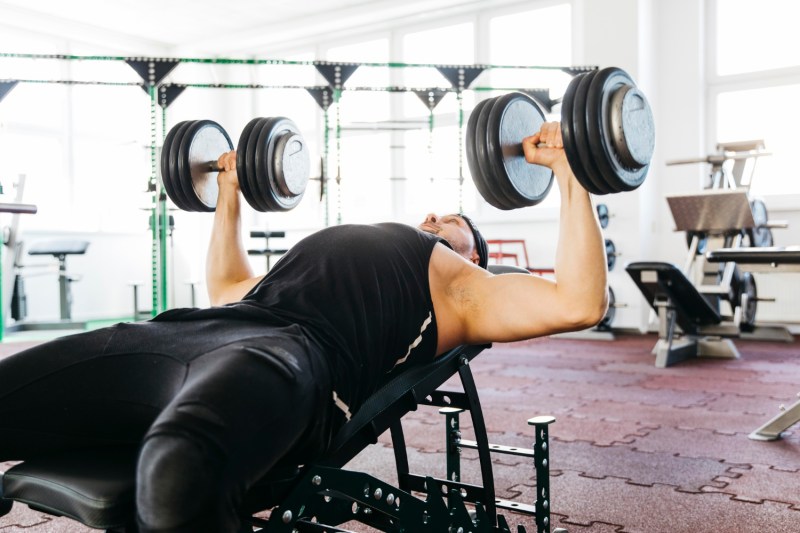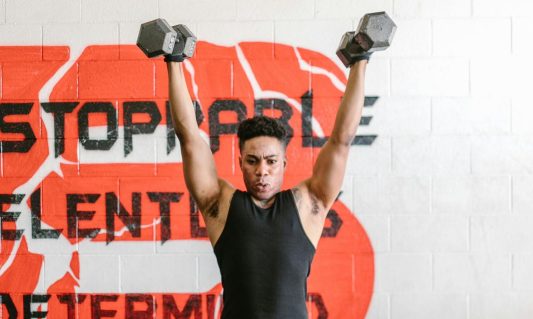Are you interested in giving a gym membership a try? As a personal trainer, I have worked with numerous people who have never stepped foot in a gym before, and their goals ranged from losing weight to building muscle to simply feeling better. No matter your ‘why’ behind your health journey, knowing which equipment to use is essential for making efficient progress.
Keep reading to discover how to choose the best types of weights for beginners, safety tips for lifting, and how to know when to increase your weights. Let’s get started!
What are the different types of weights to choose from?

According to the Mayo Clinic, “Strength training may help you develop strong bones, manage your weight, enhance your quality of life, manage chronic conditions, and sharpen your thinking skills.” If you want to reap these benefits, having a training program in place is important.
When starting out, beginners have several options for weights. Each of these has unique benefits, and you could utilize just a few or all of them.
- Dumbbells – Versatile and beginner-friendly, dumbbells allow for a wide range of movements and help improve balance by working each side independently
- Barbells – Ideal for building strength, barbells let you lift heavier loads and perform compound exercises like squats, deadlifts, and bench presses
- Kettlebells – Great for functional training, kettlebells improve strength, power, and conditioning with dynamic exercises such as swings and snatches
- Weight machines – Designed for guided movement, machines are helpful for beginners learning form or those who want extra support and safety
- Smith machines – These provide stability and safety for barbell lifts, making heavy squats, presses, and lunges more approachable for beginners
- Plate-loaded machines – Offering a mix of free weight feel and machine control, these allow users to safely lift heavier weights with guided motion
- Resistance bands – Lightweight and portable, bands mimic weight resistance while being gentle on joints, making them excellent for home or travel workouts as well
Which types of weights are best for beginners?

For beginners, the best types of weights are those that are versatile, safe, and easy to learn with. Dumbbells are ideal because they allow a wide variety of exercises, improve balance, and let each side of the body work independently. Weight machines provide guided movement, making them perfect for learning proper form while reducing injury risk. Many machines even have pictures that show you how to use them.
Kettlebells are great for functional strength and dynamic exercises, while Smith machines offer stability for heavier lifts like squats and presses. Plate-loaded machines provide the feel of free weights with added safety as well, similar to weight machines.
When choosing how much weight to lift, beginners should start with a weight that allows them to perform exercises with proper form for 10 to 15 repetitions. The goal is controlled, consistent movements rather than max effort. Over time, you can gradually increase the weight as your strength and confidence grow, ensuring steady progress without strain or injury.
Tips for getting started safely and confidently

- Always warm up for at least five to 10 minutes before lifting weights to prepare your muscles and joints and reduce the risk of injury.
- Start with lighter weights to focus on learning proper form and technique before increasing resistance.
- Use controlled movements for every exercise, avoiding jerky or rushed motions that can strain muscles and joints.
- Consider using machines or guided equipment when trying a new exercise to build confidence and stability.
- Follow a structured workout plan or routine to ensure balanced training and avoid overworking any one muscle group.
- Listen to your body and rest if you feel pain, dizziness, or excessive fatigue to prevent injury.
- Keep a workout log to track your progress, including weights, reps, and sets, so you can gradually increase intensity safely.
- Stay hydrated and fuel your body with proper nutrition to support recovery and muscle growth.
When should you increase the weight you lift?

Now that you know what types of weights you want to use, when should you increase the number of pounds you are lifting? If you notice that your current resistance starts to feel too easy and you can complete your target reps and sets with good form, then you can up the weight. This is part of a concept called progressive overload, which simply means gradually challenging your muscles more over time so they grow stronger.
Progressive overload can be achieved in several ways: increasing the weight, adding more repetitions, doing extra sets, or slowing down the movement to create more tension on your muscles. For beginners, it’s best to focus on small, consistent increases—like adding two to five pounds at a time—so your body adapts safely.
Signs it’s time to increase include finishing all your reps without fatigue or feeling like you could do several more easily. By gradually overloading your muscles, you ensure steady strength gains while reducing the risk of injury and building confidence in lifting heavier weights.
Frequently asked questions

What is the 3 3 3 rule for working out?
The 3-3-3 rule for working out is a simple approach to exercise progression. It suggests performing an exercise three times per week, for three sets, over three weeks before increasing intensity or weight. This method helps beginners build consistency, improve form, and safely progress without overtraining.
Are 20 lb dumbbells enough to build muscle?
Yes, 20 lb dumbbells can be enough to build muscle, especially for beginners or those focusing on high-repetition training. Progress comes from gradually challenging your muscles, so increasing reps, sets, or slowing down the tempo can make lighter weights effective until heavier resistance is needed for continued growth.
Is it better to lift heavier or lighter dumbbells?
Whether heavier or lighter dumbbells are better depends on your fitness goals. Heavier weights build strength and muscle mass with fewer reps, while lighter weights improve endurance and tone when used for higher reps. The best approach often combines both, ensuring balanced development and continual progress over time.




